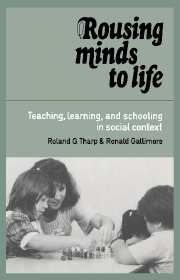Book contents
- Frontmatter
- Contents
- Acknowledgments
- Introduction
- Part I Teaching, schooling, and literacy: a unified theory of education
- 1 The redefinition of teaching and schooling
- 2 A theory of teaching as assisted performance
- 3 The means of assisting performance
- 4 The social organization of assisted performance
- 5 Language, literacy, and thought
- Part II Practice
- References
- Author index
- Subject index
4 - The social organization of assisted performance
Published online by Cambridge University Press: 05 June 2012
- Frontmatter
- Contents
- Acknowledgments
- Introduction
- Part I Teaching, schooling, and literacy: a unified theory of education
- 1 The redefinition of teaching and schooling
- 2 A theory of teaching as assisted performance
- 3 The means of assisting performance
- 4 The social organization of assisted performance
- 5 Language, literacy, and thought
- Part II Practice
- References
- Author index
- Subject index
Summary
Concentrating on the role of a single adult in direct interaction with children, as in the preceding two chapters, is useful for fine-grained analysis of the processes of assistance, but it does not fully represent the social realities of human life. It is a rare circumstance when only one person influences a learner. In the community and in schools, all teaching – including the teacher/child dyad – is embedded in complex organizations. This point is fundamental in neo-Vygotskian theory:
If Vygotsky's insights concerning the role of social interaction in psychological development are to be effectively incorporated … the links between dyadic or small group interactions and the broader socio-cultural system must be recognized and explored … actions are at one and the same time components of the life of the individual and the social system [and] will be defined and structured in certain respects by the broader social and cultural system.
(Minick, 1985, p. 257)Therefore, we cannot concentrate solely on psychological aspects of adult–child interaction. We must also consider the social context of the interaction (Rogoff, 1982); for specific examples, see Donaldson (1978).
Taking context seriously means treating the ZPD as more than a psychological phenomenon. For a ZPD to be created, there must be a joint activity that creates a context for teacher and student interaction. Once the zone is open, the “expert” can use any of the means of performance assistance described in Chapter 3.
- Type
- Chapter
- Information
- Rousing Minds to LifeTeaching, Learning, and Schooling in Social Context, pp. 71 - 92Publisher: Cambridge University PressPrint publication year: 1989



